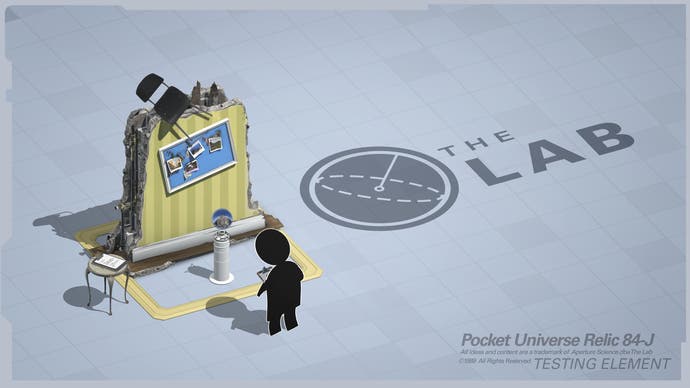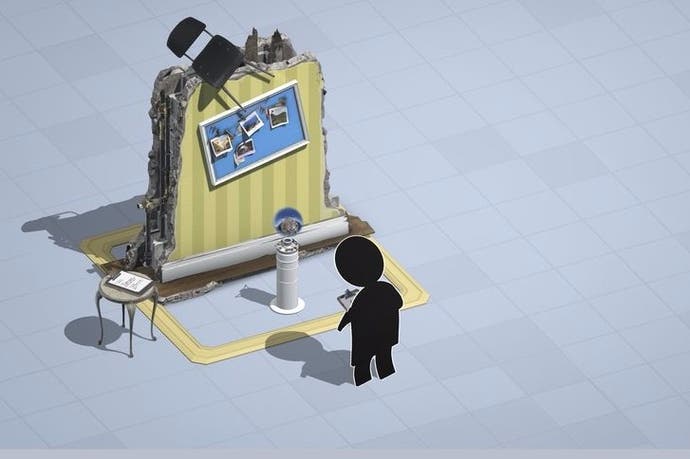Valve has a new game out soon, and it's electrifyingly good
The Lab test.
Some of you will never be happy if it's not Half-Life 3, or at least another Left 4 Dead. Some of you just want to know what's in the next update for Dota 2, Counter-Strike: GO or Team Fortress 2. Some of you are still pretending that Steam Machines are going to be a thing. And some of you are wondering if Valve is really a game developer any more, or just a particularly idiosyncratic, not to say gnomic, platform company with more revenue than it knows what to do with and a habit of half-indulging its whims. (Hello, Steam Controller.)
Well guess what, Valve the game developer still exists, and it still has the goods. At GDC this week I played Valve's next game, which will be out in the next month or so and which is bloody brilliant.
Alright, so The Lab will be free, and is no more than a Portal-themed collection of virtual reality demos designed to show off the capabilities of the HTC Vive headset. But it's no less than a totally thrilling gaming experience assembled with a characteristic mix of humour, invention and finesse. Welcome back, Valve-the-game-developer.
The Lab itself is the hub area, an Aperture Science museum-cum-den where the exhibits transport you to the demos - which you accomplish by picking up a sort of snow globe representing the space you want to visit and smashing it into your face. You'll bring back toys and trinkets from your experiences to display and examine here in all their reach-out-and-touch-it, Source 2 engine, SteamVR glory.

I tried four demos. The first and simplest was a mountain view from the summit of a peak in Washington state. This rugged panorama, barely animated but nevertheless breathtaking, was assembled from hundreds of photos. You use the Vive controllers' warp movement method - hold a button down, point where you'd like to go, and release to move there - to flick between a couple of areas that you are then free to walk around in wonder. An adorable robot dog accompanies you and it will play fetch if you throw a stick for it. Cute, and heart-stoppingly beautiful, but basic stuff as Vive's virtual spaces go.
In the second demo, I "recalibrated" a string of neurotic personality cores - the chatty robotic eyeballs from Portal 2 - by firing them out of a catapult at gigantic Jenga towers of crates and explosive barrels, causing merry destruction. This thunderous fun was helped along by a stream of laugh-out-loud one-liners delivered by the cores before you fling them to their doom. What really impresses here, as in the original Portal demo, is the Source 2 rendering. The scuffed and dented cores have an amazingly credible textural finish if you study them up close, and Portal's aesthetic, which is plain but precisely finished and exuberantly animated, is a perfect fit for VR - outlandish enough to excite, grounded enough to convince.
The third demo begins with you stepping up to a model castle on a table, leaning in to study a tiny Aperture stick figure wearing a VR headset, and clicking on it to be transported to its spot on the castle battlements. There you play an archery game, using a longbow to rattle off shots at invading stick figures. This one struck me as being less about VR itself than a use of VR to rehabilitate motion controls. Not only are the Vive controllers more reliable and responsive than Wii, Kinect or even Move, but the exact correlation between the position of your hands in real and virtual space eliminates the disconnect some motion control games suffer from and the problems they have with on-screen representation. Using the bow to draw and loose off shots is amazingly fluid, intuitive and satisfying - especially when leaning forward over the battlements to shoot at stick-soldiers below.

The best and last demo I tried encases you in a steely spherical chamber. In front of you a tiny toy spacecraft hovers. Reaching forward to pick it up, you can now fly it around as if you're a kid with a toy plane, and enemy craft spawn all around. Just aiming your ship at an enemy automatically opens fire on it, while they shoot red dots back, at first in a slow stream and eventually in a pulsing blizzard. Yes, it's a bullet hell shmup in full 3D virtual space, and it's absolutely exhilarating. At first your instinct is to dodge the enemy fire with your own body, but it's the ship you need to keep intact, and soon you get into threading it through the intensifying storm of missiles and other hazards as you line up your shots. It's a simple but gratifying arcade game in an entirely new idiom. I cannot wait to try it again.
A common worry about VR is that you don't want to spend that long in it, and that in a number of ways it's not all that compatible with the kind of luxuriant long-session gaming that so many of us enjoy. It's beginning to dawn on me that this is missing the point. The immersion VR offers is not the immersion of the epic first-person action game, or the alluring other life of an online world that you can lose days to. It's the immersion of the arcade in its 1980s/early 90s pomp: immediate, thrilling, physically involving, technologically spectacular and shit-off-a-shovel quick, it engulfs your senses. It's a bit gimmicky, perhaps, but it's also bigger and brighter and more exciting than playing games on your TV at home. You reel away after a few heart-pounding minutes and look forward to your next opportunity to have a go.
This may not be what we think of as video games now, but it's where video games came from - and now Valve, of all people, is here to remind us of it in all its frivolous, end-of-the-pier glory. The Lab may be no more than a few small but perfectly formed demos, but right now that's exactly what VR wants and needs.

